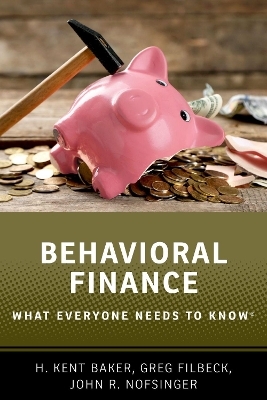
Behavioral Finance
Oxford University Press Inc (Verlag)
978-0-19-086874-1 (ISBN)
People tend to be penny wise and pound foolish and cry over spilt milk, even though we are taught to do neither. Focusing on the present at the expense of the future and basing decisions on lost value are two mistakes common to decision-making that are particularly costly in the world of finance. People are also tempted to throw good money after bad. Behavioral finance is the field that sheds light on how people make decisions and make predictable mistakes due to mental and emotional characteristics. It also provides insights into how markets operate. Having a better understanding of both can mitigate mistakes.
Behavioral Finance: What Everyone Needs to Know® provides an overview of common shortcuts and mistakes people make in managing their finances that can affect their wealth. An extensive discussion sets forth the cognitive biases or errors in thinking that occur when people are collecting, processing, and interpreting information. Emotional biases that can create distortions in cognition and decision-making are also covered, as are the influence of social factors, from culture to the behavior of one's peers. These effects vary during one's life, reflecting differences in cognitive ability due to age, experience, and gender effects. Of great importance is framing, how the presentation of a choice affects people's forecasts about the stock market, claiming social security benefits, savings behavior, mortgage choice, charitable contributions, and more.
Throughout the authors combine discussions of concepts, insights from research, and examples from recent events. Among the questions to be addressed are: How did the financial crisis of 2007-2008 spur understanding human behavior? What are market anomalies and how do they relate to behavioral biases? What role does overconfidence play in financial decision- making? And how does getting older affect risk tolerance?
H. Kent Baker is University Professor of Finance in the Kogod School of Business at American University. He has authored or edited 30 books and published more than 290 articles. His books Investor Behavior and Investment Traps Exposed received book excellence awards. Professor Baker is among the top 1% of the most prolific authors in finance. Greg Filbeck is Samuel P. Black III Professor of Finance and Risk Management and Director of the Black School of Business at Penn State Erie, The Behrend College. He has authored or edited 10 books and published more than 95 academic articles. Professor Filbeck has conducted training for professional designations for the last two decades. John R. Nofsinger is William H. Seward Chair in International Finance at the University of Alaska Anchorage. He has authored or edited 11 books that have translations in 11 languages and published 63 scholarly articles. He is author of the book, The Psychology of Investing 6th edition, which is popular with financial advisors.
Chapter 1. Foundations and Psychological Concepts
Chapter 2. Cognitive Biases
Chapter 3. Emotional Biases and Social/Cultural Influences
Chapter 4. Investor Behavior
Chapter 5. Nudge: The Influence of Frame Dependence
Chapter 6. Cognitive Ability
Notes
Index
| Erscheinungsdatum | 02.03.2019 |
|---|---|
| Reihe/Serie | What Everyone Needs To Know® |
| Verlagsort | New York |
| Sprache | englisch |
| Maße | 213 x 145 mm |
| Gewicht | 397 g |
| Themenwelt | Sachbuch/Ratgeber ► Beruf / Finanzen / Recht / Wirtschaft ► Wirtschaft |
| Wirtschaft ► Allgemeines / Lexika | |
| Wirtschaft ► Volkswirtschaftslehre ► Mikroökonomie | |
| ISBN-10 | 0-19-086874-0 / 0190868740 |
| ISBN-13 | 978-0-19-086874-1 / 9780190868741 |
| Zustand | Neuware |
| Haben Sie eine Frage zum Produkt? |
aus dem Bereich


